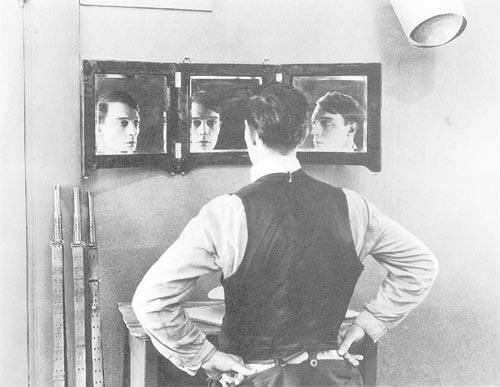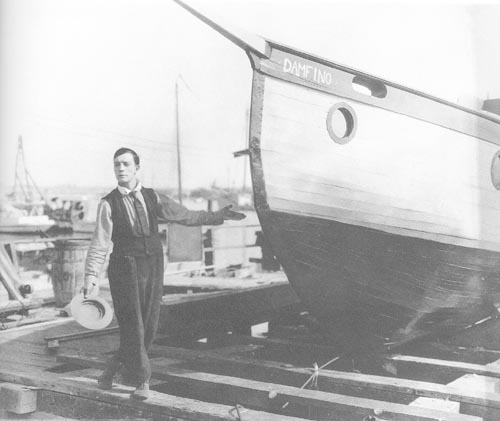9th Annual Buster Keaton Celebration
| October 3 and 4, 2002 |
| Muskegon, MI |
It was like
the scene from Buster Keaton's 1921 movie, "The
Playhouse." In it, Keaton plays every part, his
unsmiling countenance adorning every actor, musician and audience member in the
theater. Now, more than eight decades later, his great stone face was again
everywhere in the room. An elaborate
needle-pointed Keaton, which took It was the
ninth annual Damfinos Convention in |
|||||
Keaton was born Joseph Frank Keaton on
Oct. 4, 1895 in Members of
the Damfinos, the official Buster Keaton
fan club, gather each year around the time of their idol's birthday to share
their love for the deadpan, porkpie hat-wearing, comedic master they
affectionately call "Buster." Patricia
Tobias of "The cake didn't turn out," she said. "How about we start a club?" With Tobias'
sister Wendy, the three women named the organization after Keaton's
ship in his 1921 movie, "The Boat." The word's pronunciation, which
resembles "damned if I know," is a running gag throughout the movie.
Keaton also served as a matchmaker, of sorts, for Tobias. Her
involvement with the club brought her in touch with Emmy Award-winning writer
and fellow Damfino Joe Adamson. Three years ago, they
married. For Ron
Pesch, a Investigating
Keaton's connection to Then, Pesch
recalls, "She hands them to me and says, 'Take those with you. It's
obvious that you would enjoy having those.'"
Pesch's
interest in preserving
At this
year's convention, stuntman-turned-director
Cliff Cronan
screened his short film, "The Lucky Penny" to great accolades.
Produced for a paltry $300, the silent, black and white, digitally recorded
movie features Cronan doing stunts that pay distinct
homage to Keaton. |
|||||
Originally a
Jackie Chan aficionado, Cronan discovered that one of
Chan's main inspirations as a stuntman was Keaton.
Further study of Keaton led Cronan
to realize how revolutionary Keaton's stunt work was
at the time. "The
Lucky Penny" has earned rave critical reviews and revved up Cronan's career. "It all worked out pretty well. ... I
went to a film fest in Keaton's movies inspire many of the Damfinos,
but so does his life -- a roller coaster tale of struggles with alcoholism and
a lack of rewarding film work. "Even
before I saw many of his films, I read about him," said David Macleod,
announcer for the "And
sadly, most people who end up like that don't survive. The fact that he'd gone
down and then pulled himself back again, I found fascinating. And shortly
afterwards I saw the films, and the two things came together. That was
it." At this
year's Keaton has often been praised for never having to use studio
trickery for his stunts. However, careful frame-by-frame analysis by Macleod
revealed that the movie-makers, for once, probably used simple animation to
fake the dive. Much of the
conference was spent studying minutiae of Keaton's
career, in addition to an auction where Graceann Maciolek's
needlepoint sold for $2,200. On the night
of Oct. 4, the Damfinos presented six short films at
the Frauenthal Theatre with live organ accompaniment.
This gave the audience a chance to see the films in the way they were intended
to be seen. Showing some of Keaton's best work to the
public was an appropriate conclusion to a weekend spent examining all aspects
of his life. "Why are
we here to celebrate a comedian who died almost 40 years ago?" asked
unofficial fan club chronologist Steve Friedman during the convention. The question
was difficult. The answer was simple to everyone there. "Damfino!" |
|||||




